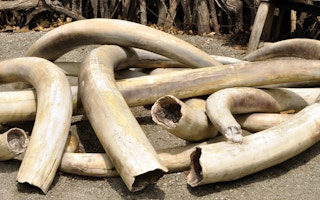Kenya is about to destroy its entire stockpile of elephant ivory. More than 100 metric tons of “white gold” – both illegally harvested (confiscated from poachers or traders) and naturally accruing (from natural mortality) – will go up in smoke this weekend.
To continue reading, subscribe to Eco‑Business.
There's something for everyone. We offer a range of subscription plans.
- Access our stories and receive our Insights Weekly newsletter with the free EB Member plan.
- Unlock unlimited access to our content and archive with EB Circle.
- Publish your content with EB Premium.
In China – where the majority of the world’s ivory is consumed or stockpiled – the recently reported price is $1,100 per kilogram, putting the total value of the material to be burned at roughly $110 million.
To most economists, the idea of destroying something with so much value is anathema. But there are good reasons for a country – even one as poor as Kenya – to surrender its ivory wealth to the flames.
For starters, stockpile destruction fortifies the credibility of demand-reduction campaigns in East Asia, without which the poaching problem will never be solved. Demand reduction aims to weaken the market for the product by changing consumer tastes. As prices drop, so does the incentive for poachers to kill elephants.
When countries keep their stockpiles, however, they signal that they anticipate being able to sell ivory in the future. This undermines the credibility of demand-reduction efforts; if the trade is likely to be legalized one day, any stigma associated with ivory consumption will be eroded.
Proponents of a regulated, legal international ivory trade argue that demand-reduction efforts can coexist with a limited legitimate supply. But this line of reasoning has a dangerous weakness: It assumes that a legal cartel – one proposed model for regulating supply – would crowd out illegal suppliers by providing ivory to the market at a lower cost.
This assumption is dubious at best. The quantities traded through a legal mechanism would be insufficient to flood the market and suppress the price. Indeed, with legalized trade undermining demand-reduction efforts, the price of ivory is likely to remain high, ensuring that poaching continues.
Some southern African countries argue that they should be allowed to sell their ivory in CITES-permitted, one-off sales to fund conservation efforts aimed at maintaining healthy elephant populations. But, aside from the low probability in some countries that the revenue would be directed to that end, it is not clear that much money would be made.
Under CITES regulations, governments are permitted to sell only to other governments. But what other governments are willing to pay may be as low as one-tenth of the illicit value. And even then, governments can sell only naturally accrued ivory, not what was confiscated from poachers or illicit dealers.
China and the United States are in the process of formulating bans on domestic ivory trade, so it is not clear which governments would be interested in purchasing African stockpiles. Vietnam and Laos are likely candidates, but they are also part of the infamous “golden triangle,” where illegal trade in wildlife and wildlife products continues to thrive.
“
When countries keep their stockpiles, however, they signal that they anticipate being able to sell ivory in the future.
The possibility of the legal ivory trade shifting to poorly regulated markets calls for a concerted international response, spearheaded by African governments through coalitions like the Elephant Protection Initiative, together with countries such as China.
Preserving – rather than burning – stockpiles is the inefficient choice. Maintaining a stockpile is administratively and operationally expensive – and often pointless. Inventory management is labor-intensive and technologically demanding. The ivory also must be air-conditioned to prevent the tusks from cracking or becoming brittle (important factors for attracting higher prices).
Given the low probability of being able to sell ivory in the future, the cost of storing and protecting it is unlikely to be recouped. Meanwhile, criminal syndicates need only corrupt a handful of local officials to make off with the goods.
Then there are the high opportunity costs of investment in maintaining stockpiles. The scarce human and financial resources allocated toward stockpile management could be more efficiently directed toward landscape preservation efforts (which can become self-sustaining over time through payment for ecosystem services).
Finally, burning ivory worth millions of dollars has an undeniable symbolic impact. It sends a clear message: Ivory belongs to elephants and to no one else. And it makes clear that elephants are worth more alive than dead.
Indeed, elephants’ value is anything but symbolic. Elephants are a keystone species for preserving important ecosystems. And yet rampant poaching is destroying elephant populations across Africa, killing, on average, 30,000 a year.
Poaching also has a negative impact on communities, benefiting a few at the expense of the many. Recent research has shown that community conservancies (areas set aside for wildlife conservation) in northern Kenya are highly effective forms of landscape (and therefore elephant) preservation, provided the right incentives are in place.
This is important because in countries like Kenya and Tanzania, the majority of wildlife exists outside formally protected areas.
Kenya should be commended for making a wise – and efficient – decision. Its neighbors, as well as countries farther south, should follow its example. Ideally, all range-state countries should destroy their stockpiles to overcome the regional collective action problem. Doing so would send an unmistakable signal to the global market: Ivory is not for sale, not now and not in the future.
Chris Alden is Professor at the London School of Economics and Political Science and a senior researcher with the South African Institute of International Affairs (SAIIA). Ross Harvey is a senior researcher with SAIIA and a PhD student at the University of Cape Town’s School of Economics.
Copyright: Project Syndicate, 2016.
www.project-syndicate.org









